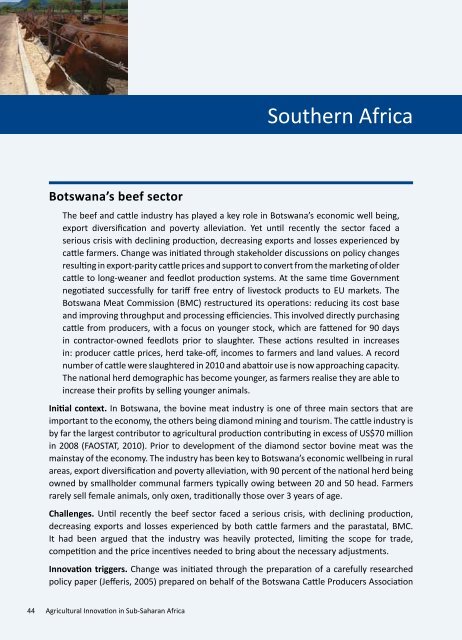1C1KKTs
1C1KKTs
1C1KKTs
Create successful ePaper yourself
Turn your PDF publications into a flip-book with our unique Google optimized e-Paper software.
Southern Africa<br />
Botswana’s beef sector<br />
The beef and cattle industry has played a key role in Botswana’s economic well being,<br />
export diversification and poverty alleviation. Yet until recently the sector faced a<br />
serious crisis with declining production, decreasing exports and losses experienced by<br />
cattle farmers. Change was initiated through stakeholder discussions on policy changes<br />
resulting in export-parity cattle prices and support to convert from the marketing of older<br />
cattle to long-weaner and feedlot production systems. At the same time Government<br />
negotiated successfully for tariff free entry of livestock products to EU markets. The<br />
Botswana Meat Commission (BMC) restructured its operations: reducing its cost base<br />
and improving throughput and processing efficiencies. This involved directly purchasing<br />
cattle from producers, with a focus on younger stock, which are fattened for 90 days<br />
in contractor-owned feedlots prior to slaughter. These actions resulted in increases<br />
in: producer cattle prices, herd take-off, incomes to farmers and land values. A record<br />
number of cattle were slaughtered in 2010 and abattoir use is now approaching capacity.<br />
The national herd demographic has become younger, as farmers realise they are able to<br />
increase their profits by selling younger animals.<br />
Initial context. In Botswana, the bovine meat industry is one of three main sectors that are<br />
important to the economy, the others being diamond mining and tourism. The cattle industry is<br />
by far the largest contributor to agricultural production contributing in excess of US$70 million<br />
in 2008 (FAOSTAT, 2010). Prior to development of the diamond sector bovine meat was the<br />
mainstay of the economy. The industry has been key to Botswana’s economic wellbeing in rural<br />
areas, export diversification and poverty alleviation, with 90 percent of the national herd being<br />
owned by smallholder communal farmers typically owing between 20 and 50 head. Farmers<br />
rarely sell female animals, only oxen, traditionally those over 3 years of age.<br />
Challenges. Until recently the beef sector faced a serious crisis, with declining production,<br />
decreasing exports and losses experienced by both cattle farmers and the parastatal, BMC.<br />
It had been argued that the industry was heavily protected, limiting the scope for trade,<br />
competition and the price incentives needed to bring about the necessary adjustments.<br />
Innovation triggers. Change was initiated through the preparation of a carefully researched<br />
policy paper (Jefferis, 2005) prepared on behalf of the Botswana Cattle Producers Association<br />
44 Agricultural Innovation in Sub-Saharan Africa


